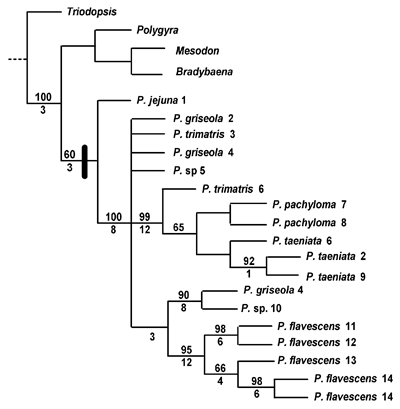The land snail family Polygyridae is native to North
America; members of this family occur in a wide range of habitats,
from humid, mixed-hardwood forests in the Southeastern US to desert
mountain tops in the Southwestern US. Polygyrids are medium to large
(~5-32 mm diameter), with reflected lips, and with shells ranging
in shape from subglobose to discoidal.
This study proposed to use morphological characteristics and nuclear
and mitochondrial gene sequences to form a phylogenetic hypothesis
for Praticolella to aid revising the group and assist in the establishment
of conservation priorities within this group. The focus of this study
is the genus Praticolella which is composed of ~15 nominal taxa. The
genus is distributed throughout the Southeastern US, Mexico, and Central
America. Praticolella griseola has been introduced to several islands
in the Caribbean and is an introduced pest in South Florida.
The common name for the genus is “scrub snails” and this
is an apt description of their habitat preferences. They are commonly
found in scrub brush under rocks, logs, Yucca, and trash. Most polygyrids
are mycophagous with foraging activity being primarily nocturnal,
when moisture is most abundant. However in more humid environments
they can be found active at any time. Several species in this genus
are considered to be of conservation concern with a G-rank of G1 or
G2, indicating that they are imperiled.
I have made collecting trips throughout Florida and the Florida Keys,
Central and South Texas, and Eastern and Central Mexico with one more
trip planned to Southern Mexico. Collections of 31 lots (>200 specimens)
of live Praticolella have been made encompassing 13 of the 14 described
species of Praticolella. Only one species of Praticolella remains
to be collected. I have not been able to obtain specimens of P. lawae,
however, I will continue to collect to attempt to find this snail
alive to include in this project. Shell-only collections make up an
additional 95 lots of Praticolella. Additional specimens and types
have been borrowed from the Florida Museum of Natural History, the
Academy of Natural Sciences of Philadelphia, and the Smithsonian Museum.
Outgroups that will be included in the study are Linisa texasiana,
Daedalochila hippocrepis, Lobosculum pustulosa, and various other
species within the Polygyridae.
DNA has been successfully extracted for all specimens of Praticolella.
Several specimens have been amplified for an approximately 800 bp
piece of the ITS-1 nuclear gene, however, these have not yet been
sequenced. 18 specimens of Praticolella and 4 outgroups have been
sequenced for the mt 16S gene. The amplified portion of this gene
resulted in ~500 bp of sequence. Samples were purified and double-stranded
DNA provided the template for cycle-sequencing using BigDye (ABI)
chemistry followed by analysis on an ABI3100 automated sequencer.
A preliminary look at relationships within the genus indicates that
the genus Praticolella is monophyletic(Figure 1); however, to draw
any final conclusions a few closely related outgroup taxa (Lobosculum
spp.) need to be included. The preliminary data also indicates that
L. Hubricht’s hybrid hypotheses for the origin of 3 species
in this genus are incorrect. A full analysis with both genes must
be finished to say this conclusively, but the initial preliminary
phylogenetic hypothesis doesn’t support Hubricht’s hybrid
species. H.A. Pilsbry’s division of P. berlandieriana into 5
species based on shell morphology does appear to be valid based on
this limited sample. Species (with the exception of P. griseola) identified
by Pilsbry’s criteria are monophyletic groups in the analysis.
An exciting result of the analysis is the detection of several distinct
lineages within the Mexican species of Praticolella. It has been speculated
(Fred Thompson pers. comm.) that there are several distinct species
of this genus in Mexico that are currently undescribed, and this is
supported by the molecular analysis.
Future Work
A few collections remain to be made. There are several distinctive
forms of Praticolella in Southern Mexico that I am trying to collect
to include in the analysis. Lab work still to be done on this project
is to sequence the remaining specimens of Praticolella for the mt
16S gene, and sequence all the specimens for LSU-1. Also underway
is an analysis of shell morphology for all species.
A further project utilizing museum specimens and distributional records
is underway. Distributional modeling is being used to examine the
environmental factors influencing distributions of species in this
genus. Comparison of distribution with phylogenetic relationships
of this group allows detailed examination of evolutionary history
of the group, can predict collection sites, and assists with conservation
efforts by defining necessary habitats.
Fig. 1. A preliminary
strict consensus tree of partial 16s mt rRNA sequences of snails from
14 numbered locations. Bar delineates the genus Praticolella.

